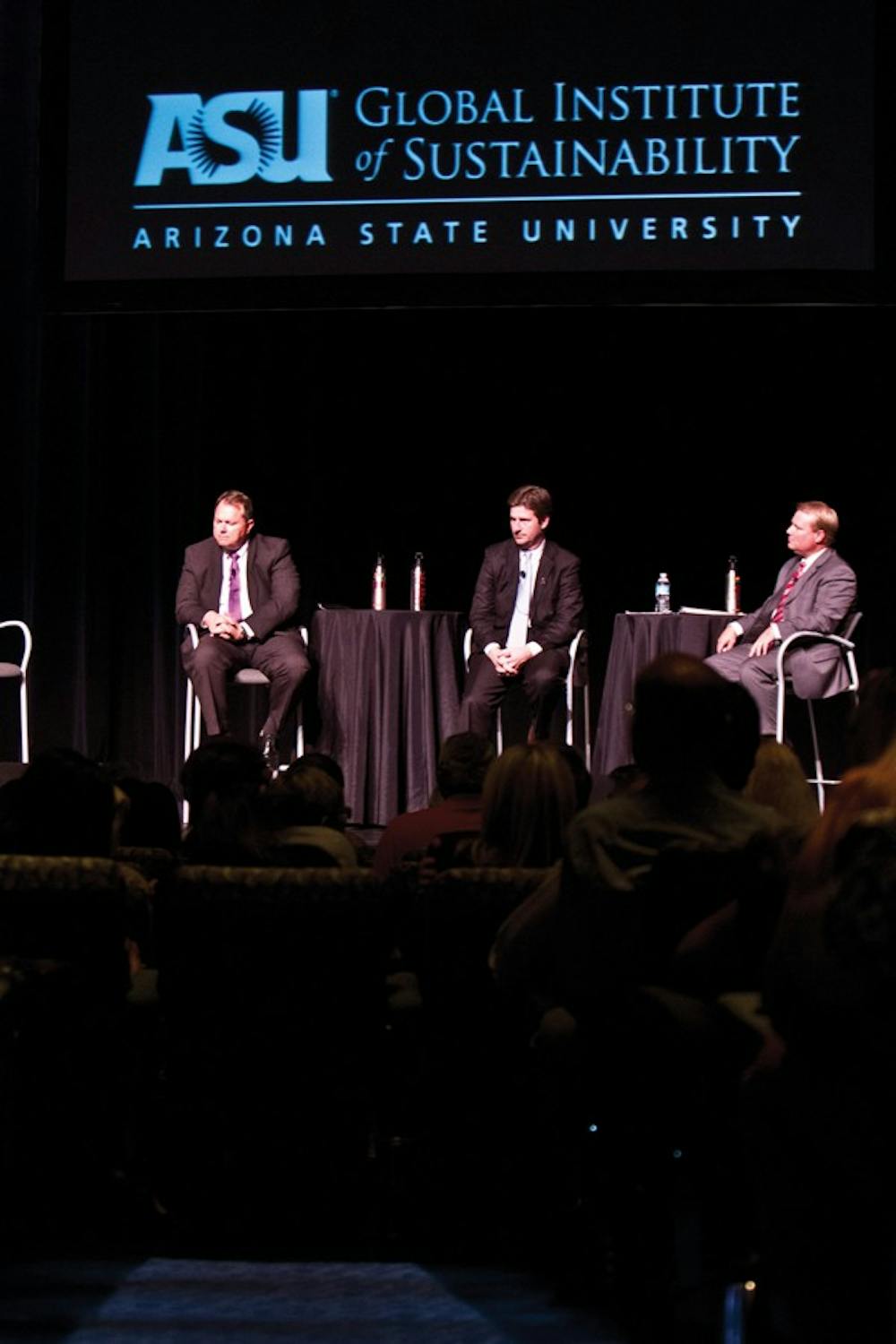 Mayors Scott Smith of Mesa, Greg Stanton of Phoenix, and Mark Mitchell of Tempe (from left to right) discussed planning for sustainability in their cities Tuesday night at the Mesa Arts Center. (Photo by Vince Dwyer)
Mayors Scott Smith of Mesa, Greg Stanton of Phoenix, and Mark Mitchell of Tempe (from left to right) discussed planning for sustainability in their cities Tuesday night at the Mesa Arts Center. (Photo by Vince Dwyer)The mayors of Phoenix, Tempe and Mesa were part of a Tuesday night forum at the Mesa Arts Center sponsored by ASU’s Sustainable Cities Network to discuss how to plan for a sustainable future.
Rob Melnick, executive dean of the Global Institute of Sustainability and the School of Sustainability, asked the mayors a variety of questions related to how each of them interpreted the concept of sustainability and what they were doing to help their cities achieve long-term livability.
Mesa Mayor Scott Smith said the Mesa City Council looked at sustainability beyond an environmental sense and included quality of life in its definition.
“We wanted a multi-generational city with neighborhoods people can visit decades from now that are environmentally sound and have opportunity and quality of life that keeps people coming back,” he said.
Mark Mitchell, who was elected the mayor of Tempe in May after previously serving as vice mayor from 2004 to 2006, said the City of Tempe also views sustainability in terms of quality of life.
He said Tempe does not have the option to expand because it has a landlocked area of 42 square miles, which makes it the densest city in the Phoenix metro area.
“Having a sustainable community network in terms of transportation has made Tempe a leader,” he said of the city’s extensive planning for bus, bike and light rail routes. “If we’re taking care of the environment, we will have better quality of life.”
Greg Stanton, who was elected mayor of Phoenix in November of last year after serving on the Phoenix City Council, said the decisions a city makes regarding sustainability involves many aspects of planning that were previously not considered.
“(It) involves everything, including transportation planning, development and zoning, historic preservation, water conservation, adaptive reuse of older buildings and planning for the aging in our community,” he said.
Smith, Stanton and Mitchell frequently referred to the Metro light rail, which spans Phoenix, Tempe and Mesa, as an example of the type of cooperation they agreed is required for sustainable city planning. The light rail is currently being extended into downtown Mesa, and plans for a connection to West Phoenix have recently been approved.
Mitchell said there is an economic development aspect to sustainability that can attract businesses and people to the region.
“It’s a great opportunity if companies and organizations see (cities) being sustainable,” he said. “It shows you are looking for ways to be more efficient.”
Mitchell said Tempe used federal grant money to retrofit government buildings to use less energy, which cut operating costs for the city when budget cuts took effect after the economic downturn.
Smith said there is a high cost of extending services to the edges of a sprawling community and that one part adds on to another when planning for sustainability.
“A great transit system creates great development opportunities and creates places where people who choose to can live an urban lifestyle, which creates walkable neighborhoods,” he said of the link between transportation and land use in cities. “For some funny reason, the economy becomes much more self-supporting and less prone to the peaks and valleys of the ‘sprawl economy.’”
Stanton said Phoenix has a Climate Action Plan to reduce emissions and is updating its general plan. He said Myplanphx.com was created to include residents’ voice in Phoenix’s commitment to becoming a more sustainable community.
“We’re doing a lot,” he said. “(MyPlan PHX) is going to be very community-based and asking questions about what their big idea for the future is.”
Interdisciplinary studies graduate student Carlo Altamirano said he wanted to hear the mayors discuss more about their strategies to engage residents in their decision-making processes.
“It’s not all about how we can improve (efficiency), but how we can have people participate and change their lifestyles,” Altamirano said.
Reach the reporter at jlgunthe@asu.edu, or follow her on Twitter @_Jgunther




